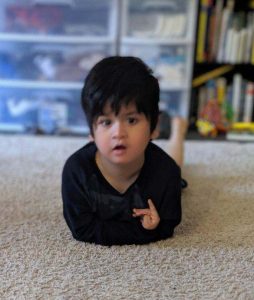 One day I came in for a session with Joey and it felt as though I was engaging with another student. He couldn’t take his eyes off his screen, and rapidly fired words at me over and over again. If the words were connected I couldn’t follow his message, and if he asked me questions he did not wait for a response. It was so unlike him and I couldn’t stop wondering what was going on.
One day I came in for a session with Joey and it felt as though I was engaging with another student. He couldn’t take his eyes off his screen, and rapidly fired words at me over and over again. If the words were connected I couldn’t follow his message, and if he asked me questions he did not wait for a response. It was so unlike him and I couldn’t stop wondering what was going on.
I kept trying to get his attention, slow him down, and ask him to pause and look at me, but he wouldn’t – word after word spurted out of the device – so quickly that I couldn’t even collect my traditional data. What was happening here? I heard this is what he was doing in school as well, and I started to question everything I’ve ever done with Joey. Was he really able to use his device to speak, or was it all just coincidence until he gained this rapid fire ability and now he just strung words together, showing us he never understood anything to begin with? [Read more…]

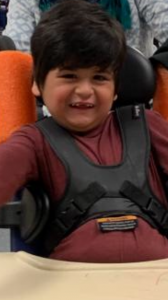 Currently, if you say hi to Joey he will quickly respond, “My name is Joey. I am five years old. My birthday is in February. I live in Virginia. Where do you live? Do you have any pets?
Currently, if you say hi to Joey he will quickly respond, “My name is Joey. I am five years old. My birthday is in February. I live in Virginia. Where do you live? Do you have any pets?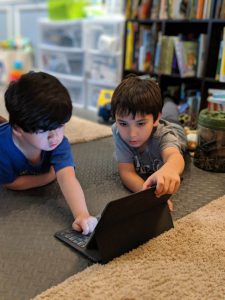 On Friday I arrived at Joey’s house to find that his eye gaze wasn’t working. For whatever reason, it was not picking up his eye gaze no matter how hard he stared at it. After tinkering with it for awhile, we reluctantly decided to have a low-tech session.
On Friday I arrived at Joey’s house to find that his eye gaze wasn’t working. For whatever reason, it was not picking up his eye gaze no matter how hard he stared at it. After tinkering with it for awhile, we reluctantly decided to have a low-tech session.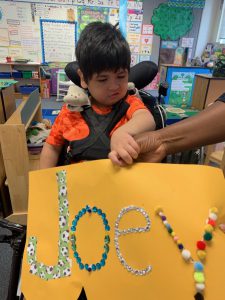 I found myself getting nervous before my opportunity to present the research on Joey’s progress at the Council for Exceptional Children’s DADD conference in January. Joey’s journey is unique, but as I scrolled through my prepared slides I wondered if I was on the right track. So much of my work with Joey has involved throwing off what I was taught in terms of behavioral approaches and meeting Joey where he asks to be met. Not what I plan for Joey to do, or what I’ve done with students in the past, but where Joey shows me he is ready to work. Although this is the right approach for Joey, and I truly believe in the approaches we take for him, I realized I was nervous about the response I would get. Sometimes it just feels too different than the otherwise straightforward approaches to teaching communication. The audience of this conference included many doctoral degrees and experts in the field. What if I was doing everything wrong, and everyone heard me say it aloud?
I found myself getting nervous before my opportunity to present the research on Joey’s progress at the Council for Exceptional Children’s DADD conference in January. Joey’s journey is unique, but as I scrolled through my prepared slides I wondered if I was on the right track. So much of my work with Joey has involved throwing off what I was taught in terms of behavioral approaches and meeting Joey where he asks to be met. Not what I plan for Joey to do, or what I’ve done with students in the past, but where Joey shows me he is ready to work. Although this is the right approach for Joey, and I truly believe in the approaches we take for him, I realized I was nervous about the response I would get. Sometimes it just feels too different than the otherwise straightforward approaches to teaching communication. The audience of this conference included many doctoral degrees and experts in the field. What if I was doing everything wrong, and everyone heard me say it aloud?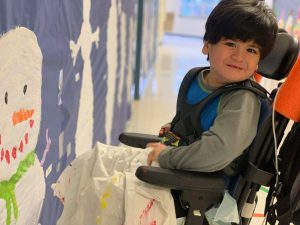 I have a love/hate relationship with knock knock jokes. For the love side, they are fun, silly, occasionally clever, and a great way to joke around with young kids. I’ve even introduced them as replacement behaviors when children want to engage with a peer but don’t know how. “Want to hear a joke?” is much better than “Our teacher is stupid and ugly” or simply pushing a peer to get their attention. So I know my fair share of knock knock jokes. On the hate side, once a child tends to learn a good knock knock joke they tend to use it repeatedly, expecting you to find it funny each and every time. And then there is that developmental window before children understand why the knock knock jokes are actually funny to other people. They create their own – “knock knock, who’s there? Cow? Cow Who? Cow cat dog dance with meeeee and the CHICKEN!” And you have to laugh even though it makes no sense.
I have a love/hate relationship with knock knock jokes. For the love side, they are fun, silly, occasionally clever, and a great way to joke around with young kids. I’ve even introduced them as replacement behaviors when children want to engage with a peer but don’t know how. “Want to hear a joke?” is much better than “Our teacher is stupid and ugly” or simply pushing a peer to get their attention. So I know my fair share of knock knock jokes. On the hate side, once a child tends to learn a good knock knock joke they tend to use it repeatedly, expecting you to find it funny each and every time. And then there is that developmental window before children understand why the knock knock jokes are actually funny to other people. They create their own – “knock knock, who’s there? Cow? Cow Who? Cow cat dog dance with meeeee and the CHICKEN!” And you have to laugh even though it makes no sense.
